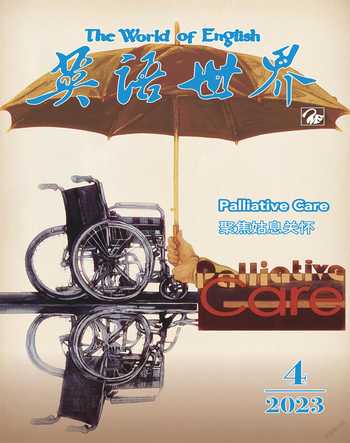Bust Misconceptions About Palliative Care打破关于姑息关怀的误解
毛思玉/译
Palliative care is often misunderstood—even by members of the medical community. Unfortunately, palliative care myths and misconceptions can prevent patients and families from accessing palliative care and its many benefits.
姑息关怀常常为大众,甚至医学人士所误解。不幸的是,相关迷思与误解会让患者和家属无缘接触到姑息关怀,也无法获得由其带来的诸多好处。
For instance, did you know the following facts about palliative care?
比如,你了解以下关于姑息关怀的事实吗?
· Patients can receive palliative care at any point during serious illness—not just at the end of life.
· 患者可在重大疾病的任何阶段接受姑息关怀,而非仅可在临终这一个阶段。
· Palliative care is not just physical care. It also includes emotional and spiritual support, among other services.
· 姑息关怀不仅提供身体护理,还可以提供情感和精神支持等服务。
· Palliative care is provided by experts to improve patients quality of life, enabling them to make the most of each moment.
· 姑息关怀由专业人士提供,以提高患者生活质量为目的,使患者能够充分利用生命的每一刻。
If you responded “no,” dont worry! Read on to learn more truths about palliative care—and bust the common myths surrounding it.
如果你不知道上述事实,没关系!这篇文章将带你了解更多关于姑息关怀的真相,为你打破与之相关的常见迷思。
Misconception: Palliative care is only for people who are dying.
误解:姑息关怀只适用于生命垂危的患者。
Patients can receive palliative care at any stage of a serious illness. The goal of palliative care is to provide an extra layer of support and increase patients comfort by addressing their physical, social, emotional, and spiritual needs. Palliative care should therefore start early in the course of illness—to reduce symptoms and suffering from the beginning, and thereby enable the best possible quality of life for the longest amount of time.
患者可在重大疾病的任何阶段接受姑息关怀。姑息关怀旨在提供额外的支持,通过满足患者身体上、社交上、情感上和精神上的需求,提升患者的舒适感。因此,姑息关怀应始于病程早期——从一开始就减轻症状与痛苦,进而在最长的时间内尽可能地提高患者的生活质量。
In other words—palliative care is to keep living, for as long and as well as possible.
换句话说,姑息关怀就是要让患者活得尽可能久,也尽可能舒适。
Misconception: Palliative care is another name for hospice care.
误解:姑息关怀是临终关怀的另一种说法。
Hospice care is simply a form of palliative care thats given near the end of life, when the patient is expected to have six months or less to live. However, not all palliative care is hospice care. Palliative care can be given to patients who still have many years to live, including those who may recover from their illness.
臨终关怀只是姑息关怀的一种形式,针对的是预期寿命不超过六个月的终末期患者。然而,并不是所有的姑息关怀都是临终关怀。姑息关怀也适用于预期寿命很长的患者,其中包括可能从疾病中康复的患者。
Misconception: Palliative care is just for people with terminal cancer.
误解:姑息关怀只适用于癌症晚期患者。
Palliative care can help people with virtually any serious condition—at any stage of illness—including terminal cancer. For example, palliative care is for people with kidney, liver, lung and heart disease, diabetes, dementia, multiple sclerosis, Parkinsons disease, and rheumatoid arthritis, among many others. People of any age—including children—can receive palliative care.
姑息關怀几乎可以帮助患有任何重大疾病的人,并且可在重大疾病的任何阶段提供帮助,包括癌症晚期。例如,姑息关怀适用于患有肾脏、肝脏、肺部和心脏疾病的人,以及患有糖尿病、失智症、多发性硬化症、帕金森病和类风湿性关节炎等疾病的人。任何年龄的人,包括儿童,都可以接受姑息关怀。
Misconception: Palliative care makes the person die sooner.
误解:姑息关怀会加速患者的死亡。
Palliative care does not hasten death. It helps the patient stay as comfortable as possible, from the start of a serious condition until the end of life. In fact, people who receive palliative care often live longer than those with the same advanced illness who do not receive palliative care, studies show.
姑息关怀不会加速生命的结束,而是会帮助患者尽可能地保持舒适,从出现重症开始直到生命结束。实际上,研究发现,患有同种晚期疾病的患者,接受姑息关怀的患者比没有接受姑息关怀的患者寿命长。
Misconception: Doctors and nurses are not experts in the field.
误解:医生和护士不是姑息关怀领域的专家。
Palliative care is a growing field. Physicians can become board-certified in hospice and palliative medicine. Nurse practitioners can earn ACHPN credentials and become an Advanced Certified Hospice and Palliative Nurse. Nurses can receive CHPN credentials and become a Certified Hospice and Palliative Nurse.
姑息关怀是一个不断发展的领域。医生可以获得临终关怀和姑息医学的职业认证。执业护师可以获得ACHPN证书,成为高级临终关怀和姑息关怀护士。护士可以获得CHPN证书,成为临终关怀和姑息关怀护士。
Misconception: Palliative care is only available in hospitals.
误解:只能在医院接受姑息关怀。
Palliative care can be given anywhere the patient lives: at home, in a long-term care facility, in a hospice center, in the hospital, or in an office setting.
姑息关怀可在患者居住的任何地方进行,包括家里、长期护理机构、临终关怀中心、医院,甚至可在办公场所进行。
Misconception: Palliative care means my doctor has given up hope for me.
误解:姑息关怀意味着医生对我已经不抱希望了。
Palliative care is an extra layer of support to help you maintain quality of life, navigate the healthcare system, and explore treatment options. Its a type of care that helps provide the best possible quality of life throughout the course of your illness. And even in situations where there may no longer be hope for a cure, palliative care helps shift the focus to new goals—centered on living each moment as fully as possible.
姑息关怀是一种额外的支持,可以帮助患者保持生活质量、寻得所需医疗资源、探索治疗方案。这种护理贯穿整个病程,为患者提供尽可能高质量的生活。即使在治愈希望渺茫的情况下,姑息关怀也有助于将患者的注意力转向诸多新目标——以尽可能充分地享受每一秒为核心。
Misconception: Palliative care is only for pain.
误解:姑息关怀只能缓和疼痛。
Pain from serious illness is a common reason to seek palliative care. But, palliative care also treats many other symptoms and challenges caused by advanced illness. These can include nausea, vomiting, shortness of breath, anxiety, depression, restlessness, spirit-ual distress, constipation, diarrhea, loss of appetite, swelling, itching, insomnia, and other issues that may affect the patients and familys quality of life.
重大疾病引發的疼痛是患者寻求姑息关怀的常见原因。但是,姑息关怀也可用于治疗晚期疾病引起的许多其他症状和问题,包括恶心、呕吐、气短、焦虑、抑郁、躁动、精神困扰、便秘、腹泻、食欲不振、浮肿、瘙痒、失眠,以及其他可能影响患者和家属生活质量的问题。
Misconception: Once I start on palliative care, I will stop seeing my other doctors.
误解:一旦我开始接受姑息关怀,我就不再看其他医生了。
Palliative care providers work with your other health care providers to help manage your symptoms and enhance your quality of life. They do not replace your other providers. The palliative care team will collaborate with your primary-care team or specialists to create a treatment plan.
提供姑息关怀的人员会与其他为患者提供医疗服务的人员合作,共同帮助患者控制症状,提高生活质量。他们不会取代患者的其他医生。姑息关怀团队将与患者的初级医疗团队或专科医生合作制订治疗计划。
(译者为“《英语世界》杯”翻译大赛获奖者;单位:北京理工大学)

